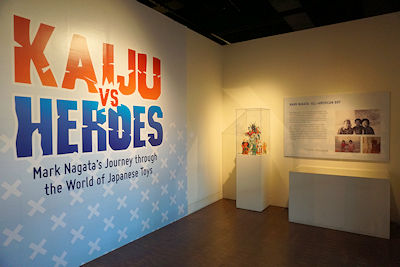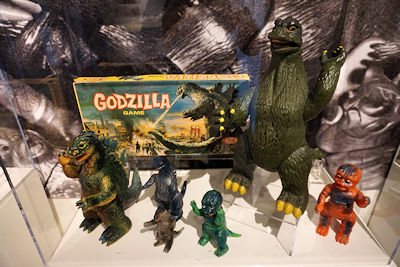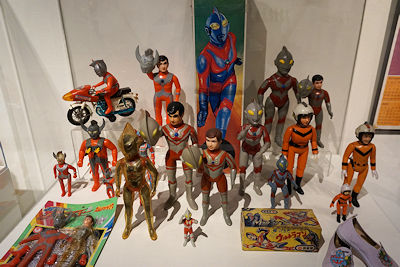
In the 1960s and 70s, an untold number of children decided to pursue careers in engineering and science because of their fascination with the original Star Trek television series. Then in 2000, it was CSI: Crime Scene Investigation that resulted in the youth of a later decade finding their vocation in the field of forensics, while the reading of comic books created new generations of artists and writers both within and outside the medium for over half a century.
For Mark Nagata, it was a box of Japanese toys received as a Christmas present when he was nine-years-old that shaped the future direction of his life. The effect of these colorful, alien-looking action figures was immediate, and Nagata eventually succumbed to the thrill of not only collecting but crafting a career as both an artist and toy manufacturer because of his infatuation with the kaiju of Japan.
In September 2018, the Japanese American National Museum in Los Angeles launched a temporary exhibit of Mark Nagata’s collection entitled Kaiju vs. Heroes: Mark Nagata’s Journey through the World of Japanese Toys. Visitors to the JANM were not only treated to the sight of hundreds of Japanese monsters and superheroes but were likewise able to share in Nagata’s journey into adulthood and enabled him to connect with his ancestral heritage and Japanese American roots as well.
Mark Nagata’s parents were both born in the United States. Coming of age during World War II, they experienced the prejudice towards Japanese Americans at the time, along with the indignation of being sent to internment camps as teenagers. Nagata’s father eventually enlisted in the U.S. Army and although the war ended before he saw battle, he was sent to Japan to assist with the rebuilding of his ancestral homeland. What he found, however, were fellow American soldiers who distrusted him and Japanese nationals who considered him a traitor to their country.
Mark Nagata’s childhood thus lacked any real connection to his Japanese heritage and was instead immersed within American culture of the 1960s. He played with G.I. Joe and Hot Wheels, enjoyed Universal horror movies and regularly visited Disneyland. But in 1973, when his Aunt Joanne – stationed on an American military base in Tokyo – sent him the aforementioned box of kaiju toys, his interests suddenly changed.
“Lining up the new figurines next to the American ones made me realize that these new toys were vastly different from the toys I was playing with,” Nagata writes in Toy Karma: The Kaiju Toy Collection and Art of Mark Nagata, a small companion book to the Kaiju vs. Heroes exhibit. “They did not resemble anything I had ever seen, and I had such a huge diet of sci-fi movies on TV. Lion-headed men, creatures with horns all over, and figures which looked like melted candles. I had no idea that these toys were mostly from Japanese TV shows. None of these shows, at the time, were playing in the U.S. It would be many years later that I eventually learned more about the toys and shows.”
As the Kaiju vs. Heroes exhibit explains, toy manufacturing was one of the first industries in Japan allowed to resume production after World War II, being seen as a non-threatening means of restoring normalcy to the country. After the U.S. occupation ended, Japan entered the world stage of pop culture with the American release of Godzilla, and future films in the series featured additional kaiju like Mothra, Rodan, and Ghidorah.
With kaiju monsters having been officially assimilated into Japanese pop culture, Godzilla creator Eiji Tsuburaya turned his attention to the superhero craze of America and designed one of the first Japanese superheroes – Ultraman. Soon toy companies like Marusan and Bullmark were mass producing both kaiju and Ultraman toys and action figures similar to the ones that Mark Nagata received for Christmas when he was nine-years-old.
As the 1970s rolled along, so did Nagata’s interests. His mother was an artist and he soon took up the craft as well. Upon graduating high school, Mark Nagata attended filmmaking classes at San Francisco City College, where he most enjoyed the storyboarding aspect of the craft. Impressed by his drawing talents, a professor suggested that Nagata switch his major to art.
The late 1980s and early 1990s witnessed a resurgence of new Japanese toys in the United States, fueling Mark Nagata’s fascination from his childhood and turning him into a collector in the process. He was likewise able to develop a successful freelance artist career during the time period, and his ability to meet deadlines further enhanced his reputation, resulting in numerous assignments that needed a quick-turnaround.
The advent of the digital age had a profound impact on the profession as fee rates dropped and companies turned in-house for design and illustration work. In need of a new career, it was the kaiju toys of his childhood that provided the answer. As fate would have it, Nagata was approached about having his collection photographed for an upcoming book on Japanese toys. During the photo shoot, he came up with the idea of publishing a quarterly magazine called Super7 that would likewise focus on Japanese toys.
Super7 allowed Mark Nagata to continue to be an artist while combining those talents with the kaiju and Ultron toys of his youth. After four-and-a-half years, however, Nagata began to tire of the endeavor and decided instead to launch his own toy manufacturing company in 2005, called Max Toy Company after his son. His first product was an action figure of an unknown superhero named Captain Maxx.
“Captain Maxx, a homage to the Japanese character Ultraman, was a fictitious Japanese superhero for whom Mark created an interesting origin story,” the Kaiju vs. Heroes exhibit explains. “According to Mark’s story, Captain Maxx was a television hero in the ’70s whose show was abruptly cancelled after one episode. A toy launch had been prepared to coincide with the premier of the TV show, but when the show was scrapped, so was the toy – except for one surviving figure. The first toy made by Max Toy Company was created to be a modern representation of this ill-fated figure.”
Mark Nagata found success with his toy company and was eventually invited to Japan by a fan of his work. It was Nagata’s second trip to the land of his ancestors and led to Max Toy Company products being manufactured in the same factories as the original Bullmark toys from the 1960s and 70s.
“A few years later, I was given a surprise tour of the Tsuburaya studios where the original Ultraman was filmed,” Mark Nagata writes in Toy Karma. “It was an out of body experience. I was standing on the very stage that Ultraman was filmed on in 1966. The stage was empty and on its way to be demolished, but I closed my eyes and breathed in the plywood smells and imagined myself back in the ’60s. I had to catch myself and think how it is possible that seemingly unrelated childhood events – toys from Japan, watching Ultraman on TV – have brought me to this moment.”
It was indeed surreal, and a testament to how the toys and entertainment of our youth can affect the path that life takes us on afterwards. Kaiju vs. Heroes at the Japanese American National Museum may have contained hundreds of toys on display, but the exhibit reflected much more than colorful action figures – the journey of Mark Nagata from childhood to adult and the ways the former ultimately shapes the latter.
Anthony Letizia





